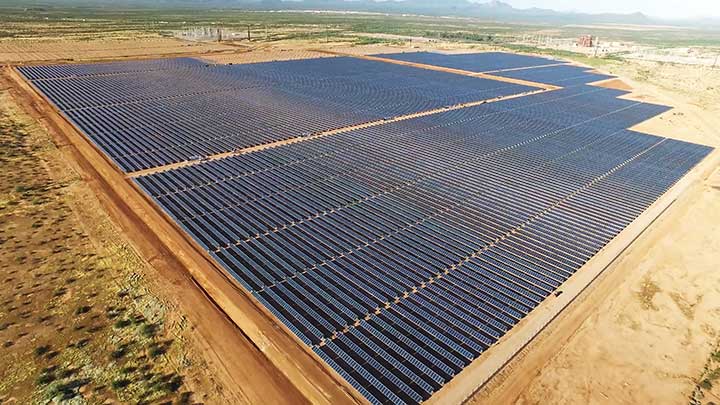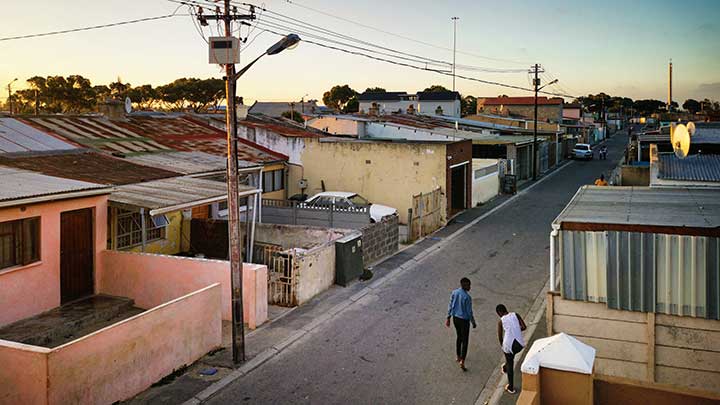Tapping Africa’s vast renewable energy resources could power a growing population and make the continent a top exporter of green fuels.
By 2040, Africa will be home to 2 billion people and need 60 percent more energy for its own economies. Flooded with sunlight and blessed with wind, there is huge potential for South Africa and other countries there to leapfrog further reliance on fossil fuels and move straight to renewables. Morocco is already leading the way by showing how development in Power-to-X technology could stimulate the transition – and help tackle difficult-to-decarbonize sectors.
By Janine Stephen
Power-to-X: Morocco to set example for Africa
Morocco, with its large-scale concentrated solar power (CSP) and PV projects, has already set a shining example of how other countries in Africa can go solar, and now it’s poised to be the first to develop its vast renewable resources into green synthetic fuels and chemicals for export through Power-to-X technology. Exporting “green molecules” such as green hydrogen or green ammonia to Europe and the rest of the world, can open up local development and economic growth across Africa, says Samir Rachidi, R&D Director for Thermal Systems and Power-to-X at the Institute of Research in Solar Energy and New Energies (IRESEN) in Rabat, the capital city of Morocco. Demand will be huge. “Everyone will have their part of the cake. It will be the new petrol in fact, the new oil. Instead of digging into the soil, we’ll have solar panels and wind turbines reaching into the sky.”
About 15 years ago, Rachidi moved to France to complete his engineering studies. He was a “sort-of immigrant” to Europe, like so many who are looking for opportunities and growth. But the burgeoning renewables industry in Morocco called him back. In the long run, he believes the industry could create tens of thousands of employees, working in areas such as desalination, renewables plants, electrolysis and chemicals by 2040. “More and more jobs are being created in Morocco, and fewer young people are dreaming a lot about Europe. If people here can find a qualifying job and be decently paid, they won’t make adventures into the Mediterranean.”
Instead of digging into the soil, we’ll have solar panels and wind turbines reaching into the sky.
Use cases and benefits for Morocco: e-Ammonia and e-Fuels
IRESEN’s latest R&D platform under development will be dedicated to green hydrogen and Power-to-X: a partnership with the innovative University Mohamed VI Polytechnic (UM6P) and a hundred-year-old phosphates company majority-owned by the state – OCP Group. One particular focus area for the partnership is green ammonia made from green hydrogen. Since 2017, IRESEN has been involved in high-level workshops and research studies on the sector’s potential, costs and opportunities for Morocco and at the end of 2020 will be publishing a roadmap on deploying the industry.
Rachidi also emphasizes the rising demand for e-Fuels worldwide that could offer opportunities for Morocco as an exporter: “The European markets need it now, especially the airlines and transport, to cut emission rates in their sectors.” Transport to Europe could be by tanker or pipelines using existing infrastructure with some extensions – less expensive than new transmission lines for green electricity.
The local benefits are clear: “Sometimes, [European clients say] they would not like to exploit Morocco or third-world countries for their own needs. We always tell them don’t worry about us, we’d be very happy to be able to export and make some local development and economic growth.”

Solar panels in the desert: North Africa alone receives more than 3,000 hours of sunshine each year that could be harnessed for electricity.
The amount annual worldwide hydrogen sales could reach, according to BloombergNEF.
Expanding a hydrogen industry throughout Africa

In South Africa, the development of a green hydrogen for export could also lower local electricity tariffs reduce carbon emissions for the country’s growing population.
A report by Frontier Economics for the World Energy Council focuses on what will drive the industry, and one pillar is demand. Rachidi notes that for green hydrogen to be more financially attractive to offtakers (European countries), incentives such as
carbon taxes and premium prices may be needed. Also, technology transfers to exporting countries will be essential for cost competitiveness. He believes it is essential for pilot plants to be set up in African countries so that business cases can
be properly contextualized, and support and buy-in will be required from both European and African governments, as well as private partners.
“We say that green hydrogen is a business not for tomorrow but for the day after tomorrow. We have time to reduce costs in a very objective way – not a way to make charity for the south, but to have a win-win situation for a business case.
I think the idea is to make a prosperous Europe, as well as a prosperous Africa. A prosperous Africa won’t only stabilize its populations, but also create a market for some European industries.” It would also create a future opportunity
for Africa to reduce its own growing carbon emissions with e-Fuels that can run existing fossil-fuel engines without the need for major technological adaptions. The technology is already there, but costs needs to be brought down to make a promising
business case.
Green hydrogen is a key component in the transition to renewables.
The economic benefits of developing low-carbon technologies in Africa
Even if African countries first scaled up their renewables to produce green hydrogen-based fuels for export, other benefits would emerge long-term. “If we get economies of scale in the production of renewables, on the back of green hydrogen production, [local] electricity tariffs will also benefit.”
An advantage of Power-to-X is that existing infrastructure can often be converted to handle e-Fuels. South Africa, for example, is home to some of the biggest synthetic fuel producers in the world – but they are enormous polluters as they use fossil fuels. Bole-Rentel believes the plants could be “converted from producing the dirtiest fuels to producing the cleanest fuels in the world – at the lowest cost. Because everybody else has to build these plants, whereas those in South Africa just have to change their feedstocks.”
Theoretically, anywhere in Africa with the capacity to make renewable power on scale and a suitable port could invest in green hydrogen products for export. “In the African context now, green hydrogen is more an export opportunity than it is for local use,” says Bole-Rentel. “But Africa needs to develop, and it’s better that it’s developing low-carbon technologies and sectors than carbon-intensive ones.”
The spin-offs for local development look promising. BloombergNEF estimates that annual hydrogen sales could amount to $200 billion to $700 billion by 2050 and meet 24 percent of world energy needs. But to get there will require the world to generate far more terawatt-hours of renewable power. In Africa, that growth needs to be exponential: Despite being the sunniest continent in the world, it currently produces less than 1 percent of the world’s solar photovoltaic energy. Developing new Power-to-X technology would help stimulate Africa’s transition to renewables and give the continent a lasting advantage in a low-carbon future.
About the author
Based in South Africa, Janine Stephen is an award-winning journalist whose work has appeared in international and local publications such as South Africa’s The Sunday Times.
Explore more topics
MAN Energy Solutions is now Everllence.
We have adopted a new brand name and moved to a new domain: www.everllence.com. This page will also be relocated there shortly. We are working on shifting all pages to www.everllence.com.
